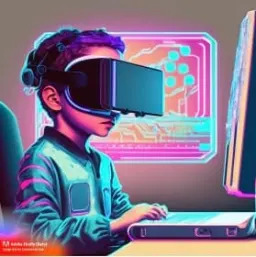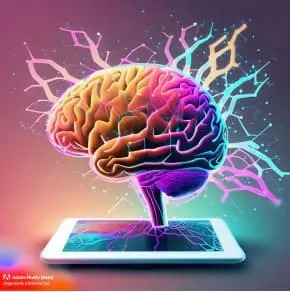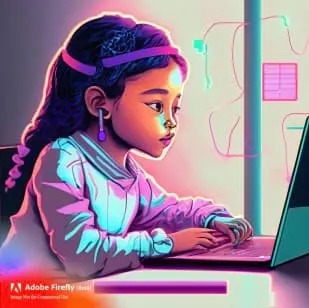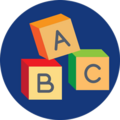Artificial Intelligence

What is Artificial Intelligence?
Artificial Intelligence (AI) involves computer systems simulating human intelligence processes. This includes learning, reasoning, problem-solving, perception, language understanding, and image and audio generation, among others that we may not yet be aware of. These advancements allow educators to leverage technology more than ever before.
AI can be categorized into two main types:
- Narrow or Weak AI: This type of AI is designed and trained for a specific task or a narrow range of tasks. It can perform these tasks very well but lacks general intelligence. Examples include virtual personal assistants (like Siri or Alexa) and recommendation systems (like those used by streaming platforms).
- General or Strong AI: This is a higher level of AI that possesses human-like intelligence and can understand, learn, and apply knowledge across a wide range of tasks, just like a human. General AI is still largely theoretical and has not been achieved yet. It would have the ability to perform any intellectual task that a human can.
Preparing Educators for AI and Student Needs
Wayne RESA will offer opportunities for educators to learn about Artificial Intelligence and how to integrate it into the classroom, including:
- Continued conversation with district leaders and instructional technology experts
- A variety of professional learning offerings throughout the 2023-2024 school year
The webpage was developed with a focus on the MITECS or the Michigan Integrated Technology Competencies for Students (Michigan Department of Ed, 2017) and the ISTE Standards for Educators and Education Leaders (ISTE, 2023). Although connections are highlighted throughout the page, we encourage all educators to explore these standards in their entirety. For your convenience, these resources are included inside the resources accordion on this page.
Note: This guidance was created by professional educators with the assistance of an artificial intelligence (AI).
The Potential of AI and Generative Models in Education
Many applications of Artificial Intelligence bring value in an educational setting (US Department of Education, 2023). These include uses that enhance productivity for educators and students, create novel interactions, enable teachers to more effectively adapt in order to meet the needs of all students, and support and augment the teaching practice (Aleven, McLaughlin, Glenn & Koedinger, 2016). AI can enhance practices and increase the capacity of teachers, yet it can never replace true human expertise. When integrated into a classroom by a highly qualified educator, AI can help prepare students for the careers of the future (ISTE, 2023). Some examples representing a bright future for the use of AI in education, include:
- Personalized learning
- Rapid differentiation of lessons and text
- Intelligence Augmentation (IA)
- Intelligent tutoring
- Analyzing Student Growth Data
- Automated grading and feedback
- Adaptive testing
While these examples represent the mere beginning of ways in which Artificial Intelligence may revolutionize learning, school districts will benefit from exploring the implementation of these applications and their overall effects on student learning (ISTE, 2023).
Current Uses of AI in Education
AI is changing the way teachers and students work in the classroom. Educators are using AI in many ways in Elementary, Secondary, Special Education, and Multilingual Education. Here are some examples:
Elementary and Secondary
- Draft lesson plans
- Provide actionable feedback to students
- Generate ideas for learning activities
- Translate text
- Develop formative and summative assessments
- Generate drafts of communication to parents, colleagues, and administrators
Special Education
- Generate ideas for meeting accommodations that meet the needs of specific students
- Make accommodations related to accessibility
Students with Special Needs
- Augment their speech and language (Augmentative and Alternative Communication)
- Support cognitive and executive functioning
- Support visual and hearing access
Administration
School Leaders are using AI tools to:
- Analyze data
- Creating schedules
- Prepare proposals
- Generate communication
- Develop ideas for engaging all stakeholders
Multilingual Education
Multilingual Students are using AI tools to:
- Interpret difficult words
- Construct sentences
- Improve their writing skills
- Learn different language skills
Teachers of Multilingual Students are using AI tools to:
- Translate texts
- Generate summaries of texts at a variety of reading levels
Educational Standards
ISTE Educator Standards for Empowered Educators & Professionals
2.1. Learner
Teachers continually improve their practice by learning from and with others and exploring proven and promising practices that leverage technology to improve student learning.
2.1.0. Set professional learning goals to explore and apply pedagogical approaches made possible by technology and reflect on their effectiveness.
2.1.b. Pursue professional interests by creating and actively participating in local and global learning networks. 2.1.c. Stay current with research that supports improved student learning outcomes, including findings from the learning sciences.
2.2. Leader
Teachers seek out opportunities for leadership to support student empowerment and success and to improve teaching and learning.
2.2.a. Shape, advance and accelerate a shared vision for empowered learning with technology by engaging with education stakeholders.
2.2.b. Advocate for equitable access to educational technology, digital content and learning opportunities to meet the diverse needs of all students.
2.2.c. Model for colleagues the identification, experimentation, evaluation, curation and adoption of new digital resources and tools for learning.
2.4. Collaborator
Teachers dedicate time to collaborate with both colleagues and students to improve practice, discover and share resources and ideas, and solve problems.
2.4.a. Dedicate planning time to collaborate with colleagues to create authentic learning experiences that leverage technology.
2.4.b. Collaborate and co-learn with students to discover and use new digital resources and diagnose and troubleshoot technology issues.
2.4.c. Use collaborative tools to expand students' authentic, real-world learning experiences by engaging virtually with experts, teams and students, locally and globally. 2.4d. Demonstrate cultural competency when communicating with students, parents and colleagues and interact with them as co-collaborators in student learning.
2.7. Analyst
Teachers understand and use data to drive their instruction and support students in achieving their learning goals.
2.7.a. Provide alternative ways for students to demonstrate competency and reflect on their learning using technology.
2.7.b. Use technology to design and implement a variety of formative and summative assessments that accommodate learner needs, provide timely feedback to students and inform instruction.
2.7.c. Use assessment data to guide progress and communicate with students, parents and education stakeholders to build student self-direction.
3.2. Education leaders
Leaders engage others in establishing a vision, strategic plan and ongoing evaluation cycle for transforming learning with technology.
3.2.a. Engage education stakeholders in developing and adopting a shared vision for using technology to improve student success, informed by the learning sciences.
3.2.b. Build on the shared vision by collaboratively creating a strategic plan that articulates how technology will be used to enhance learning.
3.2.c. Evaluate progress on the strategic plan, make course corrections, measure impact and scale effective approaches for using technology to transform learning.
3.2.d. Communicate effectively with stakeholders to gather input on the plan, celebrate successes and engage in a continuous improvement cycle.
3.2.e. Share lessons learned, best practices, challenges and the impact of learning with technology with other education leaders who want to learn from this work.
3.4. System Designers
Leaders build teams and systems to implement, sustain and continually improve the use of technology to support learning. Education leaders:
3.4.a. Lead teams to collaboratively establish robust infrastructure and systems needed to implement the strategic plan.
3.4.b. Ensure that resources for supporting the effective use of technology for learning are sufficient and scalable to meet future demand.
3.4.c. Protect privacy and security by ensuring that students and staff observe effective privacy and data management policies.
3.4.d. Establish partnerships that support the strategic vision, achieve learning priorities and improve operations.
ISTE Standards for Educators, ©2019, ISTE* (an International Society for Technology in Education), Iste.org
MITECS Standards for Empowered Teachers & Students
1. Empowered Learners
Students leverage technology to take an active role in choosing, achieving, and demonstrating competency in their learning goals, informed by the learning sciences. Students:
a. Articulate and set personal learning goals, develop strategies leveraging technology to achieve them, and reflect on the learning process itself to improve learning outcomes.
b. Build networks and customize their learning environments in ways that support the learning process.
c. Use technology to seek feedback that informs and improves their practice and to demonstrate their learning in a variety of ways.
d. Understand the fundamental concepts of technology operations, demonstrate the ability to choose, use, and troubleshoot current technologies, and are able to transfer their knowledge to explore emerging technologies.
2. Learner
Teachers continually improve their practice by learning from and with others and exploring proven and promising practices that leverage technology to improve student learning.
2.1.0. Set professional learning goals to explore and apply pedagogical approaches made possible by technology and reflect on their effectiveness.
2.1.b. Pursue professional interests by creating and actively participating in local and global learning networks. 2.1.c. Stay current with research that supports improved student learning outcomes, including findings from the learning sciences.
3. Knowledge Constructor
Students critically curate a variety of resources using digital tools to construct knowledge, produce creative artifacts and make meaningful learning experiences for themselves and others. Students:
a. Plan and employ effective research strategies to locate information and other resources for their intellectual or creative pursuits.
b. Evaluate the accuracy, perspective, credibility, and relevance of information, media, data or other resources.
c. Curate information from digital resources using a variety of tools and methods to create collections of artifacts that demonstrate meaningful connections or conclusions.
d. Build knowledge by actively exploring real-world issues and problems, developing ideas and theories, and pursuing answers and solutions.
4. Innovative Designer
Students use a variety of technologies within a design process to identify and solve problems by creating new, useful or imaginative solutions. Students:
a. Know and use a deliberate design process for generating ideas, testing theories, creating innovative artifacts, or solving authentic problems.
b. Select and use digital tools to plan and manage a design process that considers design constraints and calculated risks.
c. Develop, test, and refine prototypes as part of a cyclical design process.
d. Exhibit a tolerance for ambiguity, perseverance, and the capacity to work with open-ended problems.
MITECS, 2017. Michigan Department of Education
References
- Aleven, V., McLaughlin, E.A., Glenn, R.A., & Koedinger, K.R. (2016). Instruction based on adaptive learning technologies. In Mayer, R.E. & Alexander, P.A., Handbook of research on learning and instruction, 522-560. ISBN: 113883176X.
- European Commission. (2022). Directorate-General for Education, Youth, Sport and Culture, Ethical guidelines on the use of artificial intelligence (AI) and data in teaching and learning for educators. Publications Office of the European Union, 2022. Retrieved from https://op.europa.eu/en/publication-detail/-/publication/d81a0d54-5348-11ed-92ed-01aa75ed71a1/language-en
- Hutson, M. (2017). Even artificial intelligence can acquire biases against race and gender. Retrieved from https://www.science.org/content/article/even-artificial-intelligence-can-acquire-biases-against-race-and-gender
- ISTE. (2019). ISTE Standards, ©2019, ISTE® (International Society for Technology in Education), https://www.iste.org.
- ISTE. (2023). Artificial Intelligence in Education Initiative. Retrieved from https://www.iste.org/areas-of-focus/AI-in-education ISTE. (2023). Bringing AI to school: Tips for school leaders. Retrieved from https://cdn.iste.org/www-root/2023-07/Bringing_AI_to_School-2023_07.pdf?_ga=2.12354164.1362515014.1690540469-1178247091.1684764569
- Langreo, L. (2023). Teachers need PD on Artificial Intelligence. what it should look like. Education Week. Retrieved from https://www.edweek.org/leadership/teachers-need-pd-on-artificial-intelligence-what-it-should-look-like/2023/04
- Lieberman, M. (2022). 3 strategies for helping students navigate the ethics of artificial intelligence. Retrieved from EdWeek: https://www.edweek.org/technology/3-strategies-for-helping-students-navigate-the-ethics-of-artificial-intelligence/2022/06
- McKinsey & Company. (2023). What is AI? McKinsey Explainers. Retrieved from https://www.mckinsey.com/featured-insights/mckinsey-explainers/what-is-ai.
- Michigan Department of Education. (2017). Michigan Integrated Technology Competencies for Students (MITECS). Retrieved from https://www.techplan.org/downloads/pdfs/mitecs_document_final_2.2_721539_7_1.pdf Ohio State University. (2023). AI: Considerations for teaching and learning. Retrieved from: https://teaching.resources.osu.edu/teaching-topics/ai-considerations-teaching-learning
- Small, Z. (2023). Black Artists Say A.I. Shows Bias, With Algorithms Erasing Their History. Retrieved from https://www.nytimes.com/2023/07/04/arts/design/black-artists-bias-ai.html
- U.S. Department of Education. (2023). Office of Educational Technology, Artificial Intelligence and the Future of Teaching and Learning: Insights and Recommendations, Washington, DC, 2023. Warikoo, N., Sinclair, S., Fei, J., & Jacoby-Senghor, D. (2016). Examining Racial Bias in Education: A New Approach. Educational Researcher, 45(9), 508–514. https://doi.org/10.3102/0013189X16683408 Western Governors University. (2020). What Is AI Technology and How Is It Used? Retrieved from https://www.wgu.edu/blog/what-ai-technology-how-used2003.html
Artificial Intelligence Timeline
Reactive AI
1950s
The first chess algorithm was created in 1948 and finished in 1950 by mathematician, cryptanalyst, and "father of computer science" Alan Turing. Instead of a computer, Turing wrote lines of code on paper to plan up to two moves ahead of an opponent playing chess.
The term artificial intelligence was coined 1956 by John McCarthy for the Dartmouth Conference, the first-ever AI conference. McCarthy was an American computer scientist who, in 1958, created the Lisp computer language model. This model became the standard AI programming language.
1960s
ELIZA was the very first chatbot created by MIT professor Joseph Weizenbaum in 1966. His invention used pattern matching and substitution methodology to simulate conversation. This revolutionary breakthrough created the “Eliza effect” which refers to people's tendency to incorrectly ascribe human thought processes and emotions to an AI system, leading them to believe that the system is more intelligent than it actually is.
1970s
During the 1970s, artificial intelligence faced challenges such as reduced government support for AI research while still making advancements. Like the 1960s, the 1970s gave way to accelerated advancements, particularly focusing on robots and automatons.
Limited Memory AI
1980s
In 1984, the RB5X was created, a robot capable of learning from experience. It was a cylinder-shaped robot with an optional arm that had a transparent, dome-shaped top. Like a person, the RB5X was made up of a collection of organs and nerves that worked together to allow the robot to function and become more than the sum of its parts.
In 1985, NWEA (formerly known as the Northwest Evaluation Association) launched the MAP Growth™ assessment, a computer-adaptive assessment that measured student growth. Their AI assessment were customized for each student, and measured students progress towards grade-level standards while identifying areas that required more focused instruction.
The first commercial application of AI in the 1980s was an expert system known as the RI. RI was utilized by the Digital Equipment Corporation for configuring orders for new computer systems, and by 1986, the AI technology was so efficient it saved the organization $40m each year.
Theory of Mind AI (Present Day)
1990s
In 1990, Dragon, a voice recognition system, demonstrated a 5,000-words speech-to-text breakthrough, soon growing to 30,000. Dragon Systems were the first large-vocabulary, speech-to-text system for general-purpose dictation created. In 1997 it was publicly for DOS-based computers, utilizing the Markov Model for voice recognition. This technology created the first "continuous speech" dictation software, meaning a long pause between words was no longer necessary, thus creating the first "continuous speech" dictation.
In 1997, IBM's Deep Blue defeated world chess champion Garry Kasparov in a highly-publicized match, viewed as a symbolic victory for artificial intelligence over human intelligence. Deep Blue utilized custom VLSI chips to parallelize the alpha-beta search algorithm, which is an example of symbolic AI. The system's playing strength came primarily from its brute force computing power.
Furbies were one of the first consumer electronics to incorporate artificial intelligence and voice recognition technology. The AI version of the Furby was released in 1998, advancing the innovative technology of the original Furby to the next level by introducing machine learning.
2000s
In the year 2000 Netflix introduced a personalized movie recommendation system based on their Cinematch algorithm. The following year, the robot vacuum Roomba was released. The Roomba operated autonomously and was able to clean while avoiding obstacles. In 2003 Amazon.com launched automated recommendations for an individualized and much more personalized shopping experience.
In 2006 Facebook launched personalized news feeds and status updates. That same year, Twitter launched its communication platform with personalized curation for individual users. In 2009 Waze, a community-based traffic and navigation app, was released. That same year Grammarly, a cloud-based writing assistant, was released.
2010s
- 2011 - IBM’s Watson, a question-answering computer system, wins Jeopardy
- 2011 - Siri released for iOS
- 2012 - Google Now is integrated into Google Search to predict information users might need
- 2013 - Cortana, Microsoft's personal productivity assistant designed to help users focus on what’s most important, was released
- 2014 - Alexa launched on the Echo smart speaker system
- 2015 - Snapchat introduces Discover and Lenses, more commonly referred to as filters
- 2016 - eBay uses chatbots to improve customer service on their site
- 2016 - Google Home released
- 2017 - Apple introduces facial recognition on the iPhone X
- 2018 - Google releases Duplex, an add-on for Google Assistant that can make calls on behalf of users and perform tasks such as booking appointments
- 2019 - Zoom integrates virtual backgrounds, without the need for green screens
2020s
- 2021 (Feb. )- Microsoft releases Speller 100, useful in over 100 languages
- 2021 (Sept.) - Google study showed deep learning detected certain medical abnormalities with accuracy matching trained radiologists
- 2021 (Oct.) - IBM launches an AI service to assist in climate change analysis
- 2022 (April) - DALL-E 2, AI system generating images from text
- 2022 (Nov.) - Chat GPT 3 launched
- 2023 (March) - Google launches BARD
- 2023 (May) - Chat GPT 3 mobile app introduced
- 2023 (July) - OpenAI announced the general availability of GPT-4
- 2023 (July) - Newsela introduces AI supports for developing activities and questions
Pedagogical Considerations
AI is now part of modern life and impacts education. It can be used to improve learning but can also undermine it. The goal of AI in schools should be to enhance learning outcomes while preserving human decision-making. Therefore, AI has the potential to shift the modes and contexts of learning, enabling personalized learning and providing predictive analytics.
Educators need more opportunities to learn about Artificial Intelligence. This will help them understand what AI can and cannot do, and encourage innovation in the classroom. AI has the potential to change the way we learn, enable personalized learning, and provide predictive analytics.
Educator support for integrating Artificial Intelligence into the learning environment is critical. High quality professional learning is necessary for teachers to leverage AI effectively. Instructional coaches can assist teachers in planning and facilitating lessons that benefit student learning through AI.
To encourage authentic learning, learning environments must be adapted. Teachers should consider how changes to the classroom environment can mitigate the effects of students using artificial intelligence to auto-generate their work. This requires rethinking activity types, writing prompts, and assessment models.
The limitations of AI must be evaluated and discussed, and educators should play an active role in guiding students to understand them. This includes fostering the ability to recognize hallucinations, discern biases resulting from training data and algorithms, differentiate between human-human interaction and human-computer interaction, and grasp the implications of AI for digital citizenship.
Educational leadership must ensure that teachers have access to emerging research on the effects of artificial intelligence on student learning. Staying up-to-date with research and sharing relevant findings with stakeholders will be critical as AI continues to evolve. Additionally, educators must embrace and be responsive to new AI research, adapting to new information and models as they become available in education.
Essential Questions for Pedagogy
- What is the positive impact of generative AI tools?
- What can generative AI do for teachers, and how do we help teachers take advantage of these possibilities?
- What do students need to be able to do with AI?
- How can teachers help students leverage generative and other forms of AI?
- How can we bring pedagogical best practices together with AI?
- What impact will generative AI tools have on digital literacy skills?
- What impact will generative AI tools have on literacy skills in general?
Administrative and Policy Considerations
As Artificial Intelligence becomes increasingly prevalent, it is crucial to contemplate the practical ramifications of its accessibility to both students and teachers (U.S. DOE, 2023). When making decisions regarding the availability of AI, the following factors merit careful consideration:
- Leaders should determine AI goals, and if current guidelines and policies match those goals. Consider the practicalities of banning/limiting access. Review current guidelines around academic integrity to determine if revisions or adjustments are needed.
- School leaders should ensure that educators have access to AI tools in order to make informed decisions about the extent to which Artificial Intelligence can be integrated into learning.
- School leaders and educators must recognize that software and websites that purport to “detect” Artificial Intelligence in student work are limited in their accuracy and should not be considered to provide reliable and conclusive evidence of a lack of student academic integrity.
- Schools should adopt procedures and guidelines that directly and clearly address the use of Artificial Intelligence by school leaders, educators, and students. This should include expectations of disclosure of the use of AI, clear definitions of academic integrity as it relates to the use of AI, a clear explanation of the time, place, and context of appropriate AI use, and protocols for disciplinary action in cases of lapses in academic integrity.
- School leaders must ensure the safety and privacy of students, employees, and parents. Procedures and guidelines must be reviewed in light of the anticipated use
Essential Questions for Administration
- What implications for policy decisions and any potential guardrails might we need to consider?
- Given these considerations, how might we best keep educators and other stakeholders informed?
- What are the components that constitute a high level of academic integrity?
- How can we foster a high level of academic integrity in the work of students?
- How do we help educators and students recognize and/or screen for false information in order to prevent the use of false information?
- How do we address the ethical considerations of using AI?
- Privacy and data collection
- Transparency and accountability
- Digital divide and access to resources
- Bias
- Equity
- Intellectual freedom and censorship
- Impact on employment
- What does district implementation with AI look like?
- What disciplinary procedures are appropriate for instances such as when a student creates deep fake media that involves other students or teachers and posts it to social media?
- How can schools help victims of deep fake bullying or harassment?
Implicit Bias Considerations
Although it may seem that Artificial Intelligence (AI) would be unbiased, this is not the case (Hutson, 2017). AI is based on resources and content created by humans, and therefore has the potential to produce racist, biased, and inaccurate information. Leading AI image generator companies have committed to enhancing their tools and acknowledging bias as a significant industry-wide concern (Small, 2023). However, there is still much work to be done.
Recognizing and combating implicit racial bias in education is perhaps our greatest defense. We can study its harmful effects, encourage collaboration between researchers and scholars in racial inequality, and involve a diverse population of educators in the process. Collaboration between researchers and scholars specializing in racial inequality in education, along with a diverse population of educators, can help districts and schools recognize bias and find ways to combat misinformation (Warikoo et al., 2016).
We should focus on the following components as we seek to empower educators and students to critically examine all resources, including those created by Artificial Intelligence:
- Help students develop critical thinking skills to evaluate information and identify biases. Teach them to question the source, credibility, and evidence behind AI-generated content.
- Incorporate media literacy education into the curriculum. Teach students how to analyze and evaluate information from various sources, including AI-generated content.
- Engage students in discussions about the ethical implications of AI and the potential biases embedded in AI systems. Encourage them to think critically about the impact of AI on society and the importance of addressing bias and misinformation.
- Foster an inclusive classroom environment that values diverse perspectives.
- Discuss the importance of diverse representation in AI development.
- Encourage students to consider the perspectives of different communities and cultures when evaluating AI-generated content. (OSU, 2023)
Scrutinizing AI outputs for bias and inaccuracies is crucial. AI has flaws that can spread misinformation, especially among younger or less informed audiences who may lack the knowledge to challenge inaccuracies. Unfortunately, these errors seem to be more common among people of color or minoritized groups, which further reinforces existing biases (Lieberman, 2022).
Essential Questions
- What work can teachers and students do to uncover their own implicit biases so they may recognize when they are confronted with them in their use of AI?
- What considerations need to be made when choosing AI-powered educational tools in regard to work done by the manufacturer to address and eliminate bias in their technology?
- What measures can be put in place to regularly audit and evaluate AI systems for signs of bias?
- How can we establish clear guidelines and policies to prevent the reinforcement of stereotypes through AI-generated content?
- What structures or policies could a district put in place to ensure teachers and students confirm sources and ask questions to not miss cultural cues and misconceptions that AI computing does not understand?
- When using AI how can educators make sure the prompt is specific and inclusive enough to make sure all needed data sets are being included for a more accurate representation or outcome?
Ethical Considerations
Educating staff and students on the ethics of artificial intelligence is crucial, as the overall impact will be measured by their ability to make informed decisions about its use, regardless of whether they serve as users or creators (Lieberman, 2022).
Artificial Intelligence has the potential to revolutionize education, there are important ethical considerations to be made (European Commission, 2022). These include:
- Privacy: AI systems often need large amounts of data to function effectively. In an educational context, some uses could involve collecting and analyzing sensitive data about students, such as their learning habits, academic performance, and personal information. Therefore, maintaining student privacy is the primary ethical consideration. Even with consent, it is not appropriate to prompt public models with identifiable data because anything shared with a model, even if information is shared in prompt form, may be added to the model for future reference and even shared with other users of the model.
- Bias and fairness: AI are trained using existing datasets, leading to the potential reflection and even magnification of biases existing within these datasets. Thus, we must prepare users to recognize and respond appropriately to bias, racism, and inaccurate information. For more information please see this document’s section entitled Diversity and Cultural Considerations.
- Cultural competence: While AI has the potential to summarize content in such a way that we might better understand various cultures, results must be viewed with a critical lens. For more information please see this document’s section entitled Diversity and Cultural Considerations.
- Accessibility and equality: AI has the potential to greatly enhance learning, but if access to AI technology is not universal, it could exacerbate existing educational inequity. This includes inequalities based on socio-economic status, location, and disabilities.
- Student-Teacher relationship: AI should not replace the essential human connection between students and teachers but should serve as a tool to enhance learning. The emotional, social, and moral aspects of education are deeply human, and AI cannot replicate these.
- Dependency: In the absence of a full body of relevant research, it is to be acknowledged that over-reliance on AI technologies could pose a risk in the long run, as it may hinder critical thinking skills and problem-solving abilities in students. A balance needs to be maintained where AI is used as a tool to aid education.
Further Considerations
Additionally, incorporating media literacy education into the curriculum for teaching students so they can better instruct students on how to analyze and evaluate information from multiple sources. Teachers need to engage students in discussions about the ethical implications of AI and its potential biases while encouraging critical thinking about the impact of AI on society and the need to address bias and misinformation.
Conclusion
The advancement of Artificial Intelligence in the lives of students, educators, and educational leaders represents a pivotal moment in all aspects of life, especially in education.
Educational stakeholders are advised to adopt a measured approach in embracing this emerging technology. It’s crucial for them to acquire knowledge about AI, engage in ongoing dialogue to shape relevant policies, and explore strategies for empowering students to effectively harness the incredible capabilities of AI, thereby unlocking fresh avenues for learning and fostering innovation.

“We need to empower students to harness AI’s potential responsibly, preparing them to illuminate the world with knowledge, innovation, and boundless possibilities.”
- Beth Gonzalez
Deputy Superintendent of Educational Services
Wayne RESA

“AI will create a learning revolution, and it's only just getting started. It has the potential to help teachers and students. While we won't achieve perfection in its implementation, suppressing AI would be misguided. Instead, we must focus on empowering students and teachers to utilize AI ethically and responsibly, providing them with the necessary support to navigate this evolving landscape.”
- Alexander McNeece
Director of Instructional Services
Garden City Public Schools

“I am genuinely enthusiastic about the immense potential that AI holds in empowering students with disabilities and addressing learner variability. The prospect of leveraging AI technologies to create inclusive and personalized learning experiences is truly promising and inspiring.”
Amber Wade
Assistive Technology Consultant Wayne RESA

“When AI and human creativity come together, the possibilities are endless as it can provide a solid foundation for creating excellent learning experiences. It's like having an assistant, sparking innovation and suggesting exciting new ways to engage in learning. AI will not be the ‘be all, end all,’ but it can certainly help to build a framework for ideas."
Christopher Stanley
Director of Instructional Technology
Grosse Pointe Public School System

"AI offers educators many benefits, such as helping us increase efficiency, engagement, and accessibility. However, we must also be mindful of its barriers, including providing inaccurate information and perpetuating bias and discrimination. As educators, we must consider the risks and rewards of AI and encourage one another — and our students — to think critically about the best ways to use this tool responsibly and ethically to facilitate learning. This is where we make the difference for the well-being of children."
Ashara Shepard-Lance
Education Improvement Consultant
Wayne RESA

“Teaching students about the potential of AI goes beyond preparing them for the future; it equips them with essential life skills in the present, aiming to foster responsible and respectful digital citizenship.”
Amy Gwizdz
Elementary Educator
Dearborn Public Schools

“I am excited that Wayne County is on the forefront of AI innovation as it relates to the field of education. AI is an extremely broad subject with powerful tools for all walks of life. Leaders from across the county are working together to harness these powerful tools to help our students and the future is bright!”
Dr. John J. Tafelski
Assistant Superintendent for Curriculum & Instruction
Allen Park Public Schools
Glossary
Artificial Intelligence (AI): A field of computer science focused on developing intelligent machines capable of performing tasks that typically require human intelligence.
Chat Bot: computer program or AI application designed to simulate human conversation and interact with users through textual or auditory means
Cognitive Computing: A branch of AI that aims to simulate human thought processes and enhance decision-making by leveraging advanced technologies such as natural language processing and machine learning
Expert Systems: Computer programs that emulate human expertise in a specific domain, utilizing rules and knowledge to provide problem-solving or decision-making support Generative AI: Involves training models to create or generate new content, such as images, text, or audio, based on patterns and examples from existing data
Generative Transformers: A type of deep learning model that utilizes transformer architecture to generate creative and coherent outputs, often used in natural language processing tasks like language translation or text generation
Hallucination: an unexpected output containing falsehoods, generated by artificial intelligence models.
Intelligence Augmentation (IA): The use of AI technologies to enhance human intelligence and capabilities, enabling individuals to achieve better outcomes and solve complex problems more effectively
Intelligent Tutoring: The application of AI techniques to create personalized and adaptive learning experiences that provide tailored instruction and feedback to learners
ISTE Standards: Standards developed by the International Society for Technology in Education (ISTE), establishing a set of guidelines that define skills and knowledge required for effective use of technology in education and promote digital literacy and innovation
Machine Learning: A subfield of AI that involves the development of algorithms and models that enable computers to learn from data and make predictions or decisions without explicit programming
MITECS: The Michigan Integrated Technology Competencies for Students is a framework that outlines technology-related skills and competencies students should develop to succeed in the digital age
Neural Networks: Computational models inspired by the structure and functioning of the human brain, consisting of interconnected nodes (neurons) that process and transmit information to perform tasks such as pattern recognition, classification, and regression
Personalized Learning: An educational approach that tailors instruction, content, and pace to meet the unique needs and preferences of individual learners, often leveraging technology and data-driven insights
Reactive AI: AI system operating solely based on its immediate environment and current inputs, lacking memory or the ability to retain information from past experiences
Theory of Mind AI: AI system possessing the ability to understand and infer the mental states of others, including beliefs, intentions, and emotions, to facilitate more sophisticated human-like interaction and social understanding
Acknowledgments
Wayne RESA would like to acknowledge members of the AI Exploratory Committee for its input and insight into how AI is impacting education in local districts. Please see our homepage for current offerings and the most up-to-date information.
- Judy Bowling, Wayne RESA
- Jordan Ewert, Wayne RESA
- Jason Gribble, Riverview Community School District
- Beth Gonzalez, Wayne RESA
- Amy Gwizdz, Dearborn Public Schools
- Bob Harrison, Wayne RESA
- Zeinab Haidous, Wayne RESA
- Lisa Kaiser, Wayne RESA
- Alex McNeece, Garden City Public Schools
- Heather Palmer, Van Buren Public Schools
- Kurt Rheaume, Wayne RESA
- Ashara Shepard-Lance, Wayne RESA
- Matt Smoot, Plymouth-Canton Community Schools
- Chris Stanley, Grosse Pointe Public School System
- Jason Strzalkowski, Van Buren Public Schools
- John Tafelski, Allen Park Public Schools
- Mari Treece, Wayne RESA
- Amber Wade, Wayne RESA
- Michelle Wagner, Wayne RESA
- Scott Wagner, Gibraltar School District








